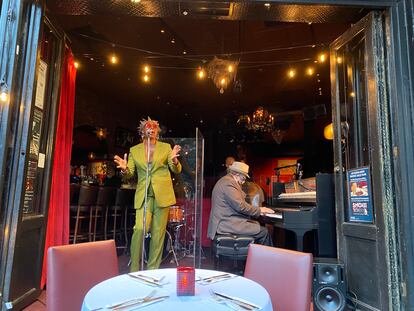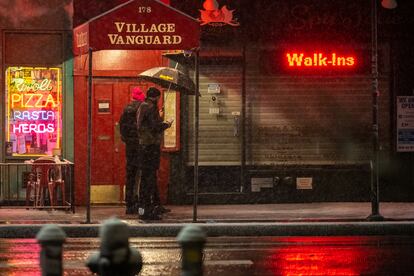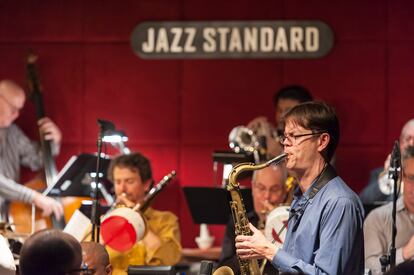New York’s jazz clubs improvise to the strains of Omicron
The coronavirus variant has set back the recovery of this historically vibrant music scene. Some jazz joints haven’t survived the pandemic.


The walls of the Village Vanguard, surely the most famous jazz club in the world, have heard many things in their 87 years (the club’s birthday was last Tuesday). But until now, they probably hadn’t heard a star pianist making reference to the Centers for Disease Control and Prevention (CDC). The Sunday after a snowstorm, Vijay Iyer, the head of his jazz trio, told the audience: “My sister works for the CDC. That’s why I’m suggesting you don’t take off your mask during the concert. We will play masked. Let’s all take care of each other.” Iyer and the double bass player Linda May Han Oh were double masked. Percussionist Tyshawn Sorey’s mask broke in the middle of one of his volcanic solos. During the intermission, Iyer crossed the room looking for Sorey, who was seated at the back, to hand him a replacement.

This is the everyday life of the world’s jazz capital in the time of Omicron, which has once again set back the return of New York’s experimental musical scene. Before the pandemic, it would have been difficult to get tickets for a band of this caliber at the Village Vanguard, which seats only 120 people. One of the waiters explained that the return had been difficult, “more than anything due to the lack of foreign tourists.” Seated at a table, Tom and Bert, two local fans in their sixties, said that it was their first time back at the mythic location “since this nightmare began.”
At another table, the pianist Marta Sánchez, of Madrid, who has lived in New York for more than a decade, seemed more optimistic. She kept going during lockdown thanks to the classes she gave on Zoom as a professor in a Brooklyn conservatory, and to “help from music associations.” She is now being signed up to perform again, and weekly concerts are becoming the norm. She has two on her books, at the Barbès and at the Bayeux, both on the other side of the river.
“The pandemic has demonstrated the enormous resilience of the players and of the clubs,” Nate Chinen, the author of Playing Changes (Alpha Decay), a book about jazz in the 21st century, said in a phone conversation from Philadelphia. Chinen, who was a critic for The New York Times and now works for the specialized radio station WBGO, believes that the pandemic has been “a productive time for musicians,” during which they have at least had time to work on new material, which will now see the light of day. He gave the example of Immanuel Wilkins, the promising young saxophonist. At 24, he’s already released two albums with the influential label Blue Note, but “he still hasn’t done his own tour,” a project he’s embarking on now.
That Sunday in New York, Sorey, one of the most interesting contemporary composers, confirmed Chinen’s suspicions, and explained that he had taken advantage of the downtime “to compose more than ever.” This week, the fruit of that concentration debuted in Houston with a piece which, inspired by Morton Feldman, celebrates the 50th anniversary of the inauguration of Mark Rothko’s chapel.
A few blocks from the Village Vanguard is the Smalls, which is run by pianist Spike Wilner, who’s also the manager of the Mezzrow. These two clubs are as exciting as they are intimate. Before sitting down to his instrument to offer a recital of standards arranged for a trio, Wilner recalled that in November, around Thanksgiving, business was once more at its peak. “People were relaxed,” he said. “We made money just as in other times. We thought that at last we were being compensated for having been able to withstand such a difficult time, the biggest threat we’ve lived through until now. Omicron arrived and people who were already vaccinated, and even those with a booster shot, began to get sick. We all got it. Omicron stopped us once again, and anxiety returned to the streets.” It also carried away the Christmas season. “Those are crucial weeks,” according to Wilner. “It’s when you harvest what you’ve sowed during the rest of the year. The concerts fill up, the streets are full of tourists, the whole world drinks without stopping...”
The odyssey of his clubs exemplifies what the scene has suffered already these past two years. They closed a few days before lockdown. And they were wrong when they thought the wait wouldn’t be too long. Programs restarted last April, with a third of audience capacity. In September, they could host at half capacity. Finally, permission arrived for full occupancy, which they haven’t taken advantage of yet: a maximum of 56 people fit in the Smalls and 40 in the Mezzrow (before, they fit 70 and 65, respectively) and one can only buy tickets on the internet, which has “taken away a certain excitement from the thing.” Both used to be the kind of tumultuous joints where one entered just by walking through the door. During the pandemic they survived by programming a daily livestreamed concert as a way to “spur donations, which arrived from all around the world.”
The Smoke, in northern Manhattan, reopened before Wilner’s clubs because they had an idea: they mounted what Paul Stache, the owner, calls “mini greenhouses.” Bands would play inside the club with all the doors and windows open. “It wasn’t the ideal musical format or sound, but people wanted it so much that it didn’t matter. So much so that sometimes it created a traffic jam in the street.” The experience that they acquired during the pandemic, when they began livstreaming on the internet, is helping to keep the flame alive now that the club is closed for renovations; they have taken the adjoining space, because “even if the virus ends,” Stache doesn’t think that “people will want to pile into a tiny joint like before.”
He’s also taken advantage of this time to record “more than ever” for his label, Smoke Sessions Records.

There were other clubs that didn’t have as much luck, and simply didn’t survive lockdown. The most tender loss has been, without a doubt, that of the Jazz Standard. It closed in December of 2020 due to “the pandemic and to so many months without income, as well as a long negotiation about rent which has stalled,” it was said at the time. In New York there are some 80 stages where one can listen to live music, according to the list that the newspaper The New York City Jazz Record prints on its last page every month. Here there are basement joints, clubs with varied programs and not just jazz, others which are the reincarnation of legendary places (Minton’s, Birdland), hotels and restaurants with music, experimental refuges in progressive universities (The Stone) and institutional spaces, like Dizzy’s, in the Lincoln Center complex. But the Standard had something special. Maybe it was the music, or the fact that you could see well from any table, or “the sensational food,” an advantage highlighted by Fred Cohen, the owner of the Jazz Record Center, the only shop dedicated exclusively to the genre in the city.
“The news of that closure was terrible,” Cohen says from behind the counter of his establishment, on the eighth floor of an anodyne office building in Chelsea. Wilner is harsher on the competition: “The owners [of the Jazz Standard] are dedicated to the barbeque business [the club was in the basement of a restaurant of the famous businessmen Danny Meyer]. The programming, which was done by a man named Seth Abramson [who didn’t respond to this newspaper’s interview request], was stupendous, but when the hospitality business failed, the music ended.” Chinen advises that there are plans to reopen soon. If that were to happen, the Standard would return to a completely different scene than that which provoked its closure. Some 77% of New Yorkers are completely vaccinated. Leaving the worst of Omicron behind, coronavirus cases have fallen 62% in the last two weeks, and hospital admissions have been reduced by half. Now the use of masks isn’t obligatory in the clubs, although it is up to the discretion of owners to demand it. Still, to get inside the majority of these places, they ask you to show a completed vaccination card (and there are even clubs that ask for proof you have received the booster).
“What we need,” thinks Wilner, “is for people to relax, to return to New York and to enjoy what we still have, even though it’s not much after two years. It’s still possible to get our lives back. It worries me that this won’t happen, because I’ve realized that I don’t love this city where I was born the way I used to love it,” he concludes. These wishes could take a while to come true. For many New Yorkers, what good news there has been still isn’t sufficient to prompt an adventure inside a club, as seen in the tables that the restaurants have scattered across the city’s sidewalks. They look full in the second winter of the pandemic, including when the temperatures drop to various degrees below freezing.
Tu suscripción se está usando en otro dispositivo
¿Quieres añadir otro usuario a tu suscripción?
Si continúas leyendo en este dispositivo, no se podrá leer en el otro.
FlechaTu suscripción se está usando en otro dispositivo y solo puedes acceder a EL PAÍS desde un dispositivo a la vez.
Si quieres compartir tu cuenta, cambia tu suscripción a la modalidad Premium, así podrás añadir otro usuario. Cada uno accederá con su propia cuenta de email, lo que os permitirá personalizar vuestra experiencia en EL PAÍS.
¿Tienes una suscripción de empresa? Accede aquí para contratar más cuentas.
En el caso de no saber quién está usando tu cuenta, te recomendamos cambiar tu contraseña aquí.
Si decides continuar compartiendo tu cuenta, este mensaje se mostrará en tu dispositivo y en el de la otra persona que está usando tu cuenta de forma indefinida, afectando a tu experiencia de lectura. Puedes consultar aquí los términos y condiciones de la suscripción digital.
Últimas noticias
Most viewed
- Sinaloa Cartel war is taking its toll on Los Chapitos
- Oona Chaplin: ‘I told James Cameron that I was living in a treehouse and starting a permaculture project with a friend’
- Reinhard Genzel, Nobel laureate in physics: ‘One-minute videos will never give you the truth’
- Why the price of coffee has skyrocketed: from Brazilian plantations to specialty coffee houses
- Silver prices are going crazy: This is what’s fueling the rally








































